|
CLICK BUTTON TO GO |
|
|
|
|
|
|
|
|
|
|
|
|
|
Videos |
|
|
|
|
|
|
|
|
|
|
|
|
|
PART 1 T O P I C |
|
|
|
|
|
|
|
|
|
|
|
|
|
|
|
|
|
|
JewishWikipedia.info
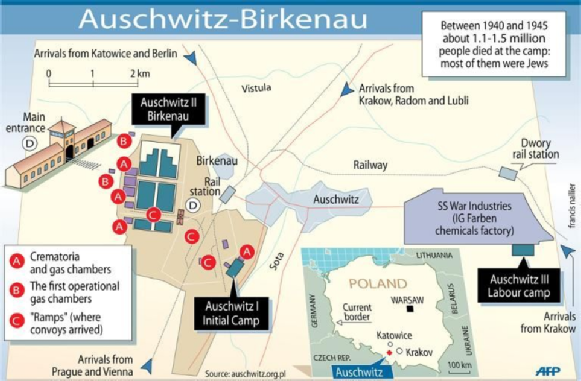
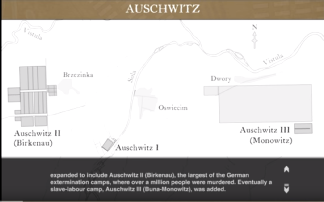
THE UNITED STATES AND THE HOLOCAUST:
WHY AUSCHWITZ WAS NOT BOMBED
During the spring of 1944, the Allies received more explicit information about the process of mass murder by gassing carried out at Auschwitz-Birkenau. On some days as many as 10,000 people were murdered in its gas chambers. In desperation, Jewish organizations made various proposals to halt the extermination process and rescue Europe's remaining Jews. A few Jewish leaders called for the bombing of the Auschwitz gas chambers; others opposed it. Like some Allied officials, both sides feared the death toll or the German propaganda that might exploit any bombing of the camp's prisoners. No one was certain of the results.
Even after Anglo-American air forces developed the capacity to hit targets in Silesia (where the Auschwitz complex was located) in July 1944, US authorities decided not to bomb Auschwitz. American officials explained this decision in part with a technical argument that their aircraft did not have the capacity to conduct air raids on such targets with sufficient accuracy, and in part with a strategic argument that the Allies were committed to bombing exclusively military targets in order to win the war as quickly as possible.
Allied bombardment of Auschwitz-Birkenau in mid-July 1944 would not have saved the approximately 310,000 Hungarian Jews whom the Germans had killed upon arrival at the killing center between May 15 and July 11, 1944. Moreover, barracks located not far from the gas chambers at Birkenau housed 51,117 prisoners (31,406 of them women and children).
In the summer and fall of 1944, the World Jewish Congress and the War Refugee Board (WRB) forwarded requests to bomb Auschwitz to the US War Department. These requests were denied. On August 14, John J. McCloy, Assistant Secretary of War, advised that “such an operation could be executed only by the diversion of considerable air support…now engaged in decisive operations elsewhere and would in any case be of such doubtful efficacy that it would not warrant the use of our resources.” Yet within a week, the US Army Air Force carried out a heavy bombing of the I.G. Farben synthetic oil and rubber (Buna) works near Auschwitz III—less than five miles from the Auschwitz-Birkenau killing center.
For prisoners in the Auschwitz complex, the bombs dropping nearby gave hope. One survivor later recalled:
“We were no longer afraid of death; at any rate not of that death. Every bomb that exploded filled us with joy and gave us new confidence in life.”
In subsequent decades, the Allied decision not to bomb the gas chambers in or the rail lines leading to Auschwitz-Birkenau has been a source of sometimes bitter debate. Proponents of bombing continue to argue that such an action, while it might have killed some prisoners, could have slowed the killing operations and perhaps ultimately saved lives.
MONOWITZ CONCENTRATION CAMP
(ALSO KNOWN AS MONOWITZ-BUNA, ~
BUNA AND AUSCHWITZ III)
Wikipedia (go to site for full article)
Monowitz concentration camp was a Nazi concentration camps and labor camp (Arbeitslager) run by Nazi Germany in occupied Poland from 1942–1945, during World War II and the Holocaust. For most of its existence, Monowitz was a subcamp of the Auschwitz concentration camp; from November 1943 it and other Nazi subcamps in the area were jointly known as "Auschwitz III-subcamps" (KL Auschwitz III-Aussenlager). In November 1944 the Germans renamed it Monowitz concentration camp, after the village of Monowice (German: Monowitz) where it was built, in the annexed portion of Poland. SS Hauptsturmführer (Captain) Heinrich Schwarz was commandant from November 1943 to January 1945.
The SS established the camp in October 1942 at the behest of IG Farben executives to provide slave labor for their Buna Werke (Buna Works) industrial complex. The name Buna was derived from the butadiene-based synthetic rubber and the chemical symbol for sodium (Na), a process of synthetic rubber production developed in Germany. Other German industrial enterprises built factories with their own subcamps, such as Siemens-Schuckert's Bobrek subcamp, close to Monowitz, to profit from the use of slave labor. The German armaments manufacturer Krupp, headed by SS member Alfried Krupp, also built their own manufacturing facilities near Monowitz.
Monowitz held around 12,000 prisoners, the great majority of whom were Jews, in addition to non-Jewish criminals and political prisoners. The SS charged IG Farben three Reichsmarks (RM) per day for unskilled workers, four (RM) per hour for skilled workers, and one and one-half (RM) for children. The camp contained an "Arbeitsausbildungslager" (labor education camp) for non-Jewish prisoners viewed as not up to par with German work standards. The life expectancy of Jewish workers at Buna Werke was three to four months; for those working in the outlying mines, only one month. Those deemed unfit for work were gassed at Auschwitz II-Birkenau.
Primo Levi, author of If This Is a Man (1947), survived Monowitz, as did Elie Wiesel, author of the Pulitzer Prize–winning book Night (1960), who was a teenage inmate there along with his father.
The new Buna Werke or Monowitz Buna-Werke factory was located on the outskirts of Oświęcim. The plant construction was commissioned by the Italian State interested in importing nitrile rubber (Buna-N) from IG Farben after the collapse of its own synthetic oil production. The 29 page-long contract signed by the Confederazione Fascista degli Industriali and printed on 2 March 1942 secured the arrival of 8,636 workers from Italy tasked with erecting the installations with the investment of 700 million Reichsmarks (equivalent to 2 billion 2009 €) by IG Farben (Farben was the producer of nearly all explosives for the German army, with its subsidiary also producing Zyklon-B). The synthetic rubber was to be made virtually for free in occupied Poland using slave labor from among prisoners of Auschwitz, and raw materials from the formerly Polish coalfields. The Buna factory had a workforce of an estimated 80,000 slave laborers by 1944.
According to Joseph Borkin in his book entitled The Crimes and Punishment of IG Farben, IG Farben was the majority financier for Auschwitz III, a camp that contained a production site for production of Buna rubber. Borkin wrote, wrongly, that an Italian Jewish chemist, Primo Levi, was one of the upper level specialists at the Buna plant, and was able to keep some prisoners alive with the assistance of his colleagues, allegedly not producing Buna rubber at a viable production rate. In fact Levi was only an inmate there who, in the last two months of his captivity, was sent to a chemical lab due to his former studies as a chemist. Buna Rubber was named by BASF A.G., and through 1988 Buna was a remaining trade name of nitrile rubber held by BASF.
By 1942 the new labour camp complex occupied about half of its projected area, the expansion was for the most part finished in the summer of 1943. The last 4 barracks were built a year later. The labor camp's population grew from 3,500 in December 1942 to over 6,000 by the first half of 1943. By July 1944 the prisoner population was over 11,000, most of whom were Jews. Despite the growing death-rate from slave labor, starvation, executions or other forms of murder, the demand for labor was growing, and more prisoners were brought in. Because the factory management insisted on removing sick and exhausted prisoners from Monowice, people incapable of continuing their work were murdered. The company argued that they had not spent large amounts of money building barracks for prisoners unfit to work.
On 10 February 1943 SS-Obersturmbannführer Gerhard Maurer, responsible for employment of concentration camp prisoners went to Oświęcim; he promised IG Farben the arrival of another thousand prisoners, in exchange for the incapable factory workers. More than 10,000 prisoners were victims of the selection during the period in which the camp operated. Taken to the main camp's hospital, most victims were killed by a lethal injection of phenol to the heart. Some were sent to Birkenau where they were liquidated after “re-selection” in the Bllf prison hospital or in most cases murdered in the gas chambers. More than 1,600 other prisoners died in the hospital at Monowice, and many were shot at the construction site or hanged at the camp. Summing up all figures, an estimated total number of about 10,000 Auschwitz concentration camp prisoners lost their lives because of working for IG Farben.
List of subcamps of Auschwitz Wikipedia
SIGINT AND THE HOLOCAUST
DOCID: 3674579 UNCLASSIFIED Approved for Release by U.S.A. Or D3-22-2010 FOIA Case# 6030'9 SIGlNT from British and French sources provided a limited but authentic picture of the early stages of the Holocaust. This information was made available to Prime Minister Churchill and, in midwar, to the U.S. Churchill recognized the importance of the information and used it in at least OM mqJor speech (without reference to the source). In this article we will review the SIGINT, compare it to other sources of information, and comment on a number of controversies including the bombing of Auschwitz.
NSA, Cryptologic Quarterly, Robert Louis Benson
Mr. Benson is chief, M5J. He is a career employee of the NSA Office of Security (Mo) and formerly a captain in the USAF. He has written and lectured on a number of SIGINT and counterintelligence topics.
There are too many sources to cite: call me for a reading list, 963-1978s or (301) 688-5052b.
USA REJECTS BOMBING OF AUSCHWITZ WW2HISTORY.COM
In April 1944 two prisoners, Rudolf Vrba and Alfred Wetzler, managed to escape from Auschwitz. And the information they gave to the Allies – together with intelligence gained from two other prisoners who escaped shortly afterwards – formed the basis for a report on the workings of Auschwitz that became known as the Auschwitz Protocols.
BOMBING OF AUSCHWITZ, SHOAH Resource Center
WHY WASN'T AUSCHWITZ BOMBED? Encyclopedia Britannica, Michael Berenbaum
Allied forces knew about Holocaust two years before discovery of concentration camps, secret documents reveal Independent, Andrew Buncombe 17 April 2017
Pope Francis: Why didn't allies bomb railway routes taking prisoners to …
Independent 22 Jun 2015
The Pope has attacked the world's “great powers” for failing to do more to protect the victims of the Holocaust, asking why they did not bomb railway routes used to carry prisoners to Auschwitz.
Why the allies didn't bomb Auschwitz The Guardian 9 Sept 2009
When the US war department was petitioned by Jewish representatives to bomb Auschwitz, it refused
JAN KARSKI ABOUT HIS MEETING WITH PRESIDENT FRANKLIN D. ROOSEVELT, 1943
JanKarskiProgram 2012 (8.33)
Created by Claude Lanzmann during the filming of SHOAH Jerusalem
THE AUSCHWITZ BOMBING CONTROVERSY IN CONTEXT
Yad Vashem 2010 (17.00)
Dr. David Silberklang, Editor of Yad Vashem Studies, discusses the controversial decision of the Allies in regards to bombing the Auschwitz-Birkenau death camp in 1944.
Aerial Photographs of Auschwitz:
https://www.yadvashem.org/yv/en/exhib...
The lecture is part of the series "Insights and Perspectives from Yad Vashem Historians." For more lectures, click here: http://www.yadvashem.org/holocaust/vi...
THE NAZIS
AND FINAL SOLUTION MAP. EXTRACT
OF AUSCHWITZ CAMPS(I , II AND III)
BBC Auschwitz-
Oswaldo Armendariz 2014 (15.04)
WHY DIDN'T THE ALLIES
BOMB THE CAMPS?
Professor Stephen Berk, (Union College)
Larry Rachlin 2013 (10.03)
why the Allies did not bomb Auschwitz nor the train lines leading to the Nazi concentration camps.
Recorded at the Beth Tzedec Congregation, Toronto, Canada.
WHY
WASN'T AUSCHWITZ BOMBED?
Center for Online Judaic Studies 2016 (52.17)
What prevented the Allies (and especially the Americans) from responding
to the evil of Auschwitz?
|
The USA and the Holocaust. |
Monowitz Concentration Camp (also known as Monowitz-Buna, Buna and |
HOLOCAUST
AUSCHWITZ -
WHY NO BOMBING OF CAMP, ONLY OF FACTORIES
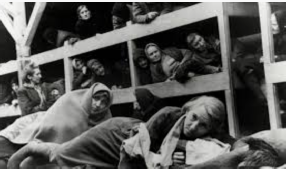
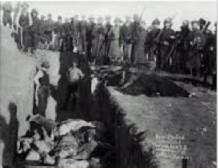
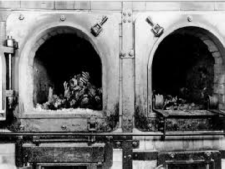
THE
INCREDIBLE
STORY OF THE JEWISH PEOPLE
